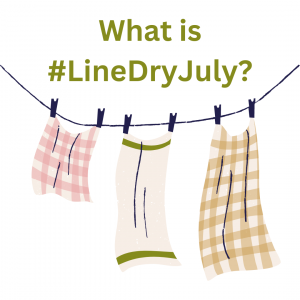
Line Dry Now
Let’s create a new norm for clothes drying in Canada. Take our line dry challenge for the month of July. Find out more below.
Why?
Doing the laundry is environmentally taxing. Laundering uses water and energy and releases microplastics and chemicals into the environment. Among laundry-related tools, the clothes dryer is the most energy-intensive, using 25 times more energy than the washing machine.1 In fact, among all household appliances, the electric clothes dryer accounts for the most significant share of GHG emissions.1 The clothes dryer is also a direct source of microfibres to the outdoor environment.2,3
North Americans use electric dryers more than anyone else globally.2 In most other countries, drying clothing by line, either indoors or out, is the norm.4,5 Reducing your reliance on the clothes dryer as the go-to method for drying your laundry will help reduce your household’s GHG emissions and save you money on your monthly electricity bills.
It’s time to rethink our laundering practices. The clothes dryer is a convenient tool for doing the laundry, but in Canada, we have become all too dependent on it.
What can you do?
Stop using the electric clothes dryer to dry your laundry for the entire month of July. Instead, use the natural resources of sunshine and wind to dry your clothing, sheets and towels outdoors on a clothesline or a drying rack.
Prepare yourself and your family, and find a space indoors where you can place a drying rack for those days when the weather or air quality is not conducive to outdoor drying.
For tips and updates:
Become part of our community of laundry rethinkers and change-makers:
- Follow us on Instagram (@linedrynow) and Facebook
- Share your line-drying journey by using the hashtag #LineDryJuly
- Check out our resources page.
Already a line dryer?
Join us, too! Your experiences and commitment can help us grow a community where one day we'll see drying by line as a Canadian norm.

References
- Natural Resources Canada. Comprehensive Energy Use Database. Accessed June 20, 2023. https://oee.nrcan.gc.ca/corporate/statistics/neud/dpa/menus/trends/comprehensive_tables/list.cfm
- Kapp KJ, Miller RZ. Electric clothes dryers: An underestimated source of microfiber pollution. PLoS ONE. 2020;15(10):1-17.
- Tao D, Zhang K, Xu S, et al. Microfibers released into the air from a household tumble dryer. Environ Sci Technol Lett. 2022;9(2):120-126. doi:10.1021/acs.estlett.1c00911
- Daystar J, Chapman LL, Moore MM, Pires ST, Golden J. Quantifying apparel consumer use behavior in six countries: Addressing a data need in life cycle assessment modeling. J Text Appar Technol Manag. 2019;11(1). https://jtatm.textiles.ncsu.edu/index.php/JTATM/article/view/14770
- Spencer J, Lilley D, Porter S. The opportunities that different cultural contexts create for sustainable design: a laundry care example. J Clean Prod. 2015;107:279-290. doi:10.1016/j.jclepro.2015.04.082

